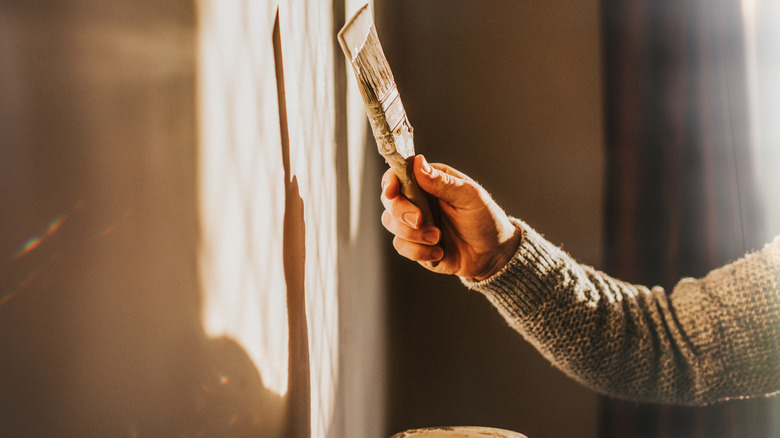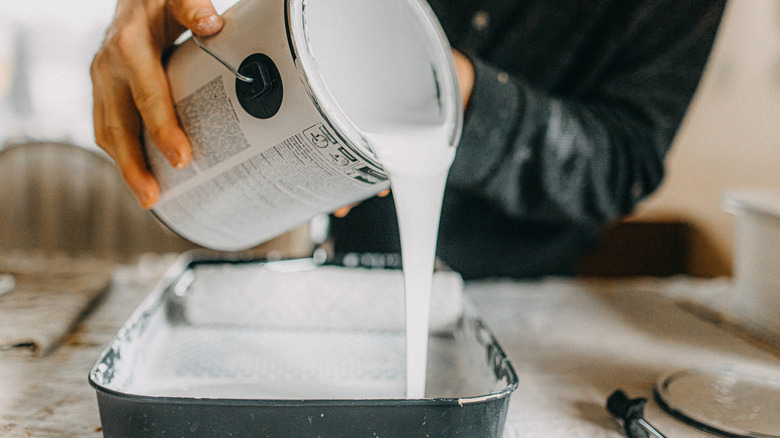The Decades-Old Paint Trend That's Making A Comeback (& How To Get The Look)
Recent interior paint trends feature lots of neutral colors and satiny smooth walls. While this contemporary look appeals to many, there are some who find it to be a bit boring. Plain walls with no texture can feel sterile, flat, and uninspiring, which can make a space seem lifeless and uninviting. Interior paint trends from previous decades, though, featured more dynamic styles. From the vibrant colors that covered people's walls in the 1960s to the swirl-patterned walls of the 1970s, decades past can give us some great guidance on how to break up the monotony and create a visually-appealing atmosphere through interior wall paint.
One of the decades-old painting trends involves making scallop shapes (also called a fan pattern) that cover the entirety of a room's walls. If you are over the age of 40, you may have seen these scallop patterns on the walls of your childhood home. These scallop shapes are sometimes still painted on the ceilings of rental homes and apartments by contractors. This is because the pattern is not only more visually appealing than a regular popcorn ceiling, but it also helps to hide imperfections.
This way of adding texture to walls is making a comeback, which is great news for those looking for ways to add dimension to their living space. More great news is that achieving this look is fairly simple. For this project, you need a plastic V-notch trowel, joint compound, a paint roller, and latex paint.
How to create a textured scallop pattern on your walls
You first need to mix the paint with the joint compound. You'll do this by slowly pouring the paint into a bucket of compound until your desired color and texture are achieved — the thickness should be similar to pancake batter. (To avoid making a mess on this step, you can try the paper towel hack from TikTok.) Then, use a paint roller to cover your wall evenly with a thick layer of joint compound. You will want to use a roller with a ½-inch nap since you need it to apply a significant amount of your joint compound and paint mixture. Then, use your trowel to trace a comb pattern around the edges of your wall, from corner to corner and floor to ceiling. (Don't worry about the lines being wavy. This step is so that you don't have any stippling peeking from the edges of your scallop pattern.)
After you've done that, it's time for the fun part — making your textured scallops. Starting at either upper corner of your wall, lightly touch your V-notch trowel to the compound mixture and, while holding the corner of the trowel steady, move the toothed edge to form a semicircle pattern. Form your next semicircle, slightly overlapping your first one, and continue this process over the entirety of your wall.
Important considerations before starting your project
Before you start this project, it's a good idea to know the exact look you're going for. If you envision larger scallops, you may want a larger trowel. Also, trowels come with different teeth sizes, which will change the look of the scallops. If you want to add more dimension to your newly-textured walls, you might consider adding an analogous color to your scallops. For example, if your wall color is red, you could dab the tips of your trowel teeth in a shade of orange just before forming your scallops. You could also have this secondary paint color match your floors. There are many different directions you could go with this project, so let your creativity run wild.
Apart from the appearance of your scalloped wall, there are some other important things to consider. You may want to prime your walls before applying the joint compound mixture to make sure the color and texture of the end result are even. The joint compound and type of trowel you choose are critical as well. You want to avoid quick-drying joint compound and instead choose one that is labeled "air dry" or "pre-mixed". This is so that it doesn't dry before you've finished forming all of your scallops. When choosing a trowel, plastic is preferred over metal since metal could potentially scrape off pieces of drywall, which would end up in your scallops.

